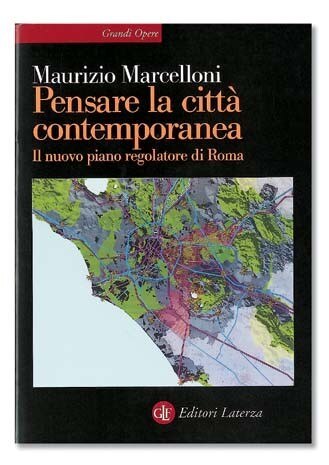Pensare la città contemporanea. Il nuovo piano regolatore di Roma Maurizio Marcelloni Editori Laterza, Roma 2003 (pp. 236, € 29,00)
The search for a sustainable, non-utopian plan for the city attempts to halt urban sprawl or fragmentation. ‘Constant developments’ appear to lead to the ‘metropolization of the region’, if a metropolis is taken to be the same as a big city. But this does not correspond to Rome’s real significance as the mother of cities.
It does not allow us to pinpoint the content and meaning of the contemporary town. Globalization is rampant and there is no planning. It is not like Milan or other places. Contradictory disguises, such as new zoning laws, try to surrogate the missing plans and the lack of reference paradigms. To address complexity one falls back on sustainability, networks and pioneering technology, not to mention the government of new and vague regional authorities. Planning tools are often translated into political or administrative slogans.
Pensare la città contemporanea. Il nuovo piano regolatore di Roma by Maurizio Marcelloni offers much food for thought. According to the author, Rome is ‘emblematic of the more general difficulties involved in solving complex, ineluctable issues’. The question is whether the same problems manifested elsewhere are solvable. Marcelloni does provide an extensive historic overview of Rome, but some comparisons – such as London during the same period, rather than the somewhat threadbare Spanish examples – might have been useful.
This is even more necessary since the Italian trade journals have transformed themselves into tabloids, and architectural and planning problems are increasingly relegated to newspaper inserts. The author wants to avoid being taken for a militant critic, which will be tough since he headed the municipal planning office from 1994 to 2001, during Rutelli’s mayoralty.
This is why he probes in depth the history and plans, failures and hopes of the capital’s last 50 years. Unfortunately, Marcelloni fails to underscore some of Benevolo’s extraordinary proposals for the historic core, though he does point out the mistakes. Three deep chapters precede the book’s main fourth chapter, which bears the objective title ‘Approving the New Master Plan’.
Only 12 pages compare the proposal of the Rutelli plan to Veltroni’s proposal, describe the modifications of the proposed plan by Veltroni’s government and explore the perspectives of the old city plan. Then comes a concise summary of the two years when Marcelloni no longer directed the planning office. The plan had a new name and some new contents. Apparently, the differences between them are not arresting.
In fact, the Rutelli Council abandoned the strategic plan (in Marcelloni’s opinion, it was the mainstay of the planning innovations), paving the way for a brand-new plan. As the former head puts it (to be very concise), its technical rules are overly stringent, the new central features and communes are gone and the compensation mechanisms are have been slashed. Having ceased any objective slant, Marcelloni’s critique of the Veltroni Plan may be overdone.
Yet it does substantially defend the new, envisaged volumes, which everyone thought unwarranted. Now we ought to call in William Faulkner, a great writer who could perhaps make the other players talk – beginning with the general consultant, Campos Venuti: did he sign or not? And the two mayors, plus a host of other protagonists and opponents of the plan. It should be like in Faulkner’s The Sound and the Fury – after all the versions and interpretations of the same facts, one could gain a better understanding.
For instance, how many brand-new cubic metres does the plan envisage? What is the meaning of the reserve or transformation areas? They seem to be land for new structures. Are they extra cubic metres, to be erected after the projected volumes? And what about the volumes built before, during the lengthy period of ‘planning as you go’: are they to be added or subtracted from the certainties? Everybody hopes for strong medicine, but will this treatment give the desired results if it is performed? Won’t the overdose of various kinds of expressways and beltways cause traffic jams as a side effect? If the new communes did come to life, how could they independently determine their organization and central features with a plan that has both rigid norms and a fussily defined organization throughout the municipality?
‘Planning as you go’ delayed the city’s master plan with a lot of half-steps. The certainty plan quantified and justified the building fury characteristic of Rome since it became the capital. The strategic plan laid out the timeline and methods. But, in the end, what scheme did the Rutelli-Veltroni Plan spawn? Do we have to wait for the opinion of the regional technical committee? Regardless, it appears that the city councils of Italy’s large and medium-size towns – no matter which parties were in power or what the authority of the mayors – have renounced the programming of their future organization.
The regions delegate this power to the provinces. Even the (few) provinces with the proper tools cannot relate to the provincial capital. The technicians remain silent (or grumble about one another) and the citizenry endures.
Pier Luigi Cervellati Professor of Urban and regional rehabilitation at the University of Venice


